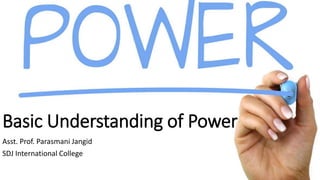
Organizational Power
- 1. Basic Understanding of Power Asst. Prof. Parasmani Jangid SDJ International College
- 2. Meaning • Power refers to a capacity that has to influence the behaviour of another person so the other person acts in according with One’ s wishes. • Power is the ability to convince people to agree to your views and get the work done accordingly. • According to Dahl (1957), “The concept of power is as ancient and ubiquitous as any that social theory can boast”. • According to Sheriff, “Power denotes the relative Weights of behavior by a member in a group structure.”
- 3. • Organizational power is the ability that you have to influence the behavior of another stakeholder in your organization. The power is measured by the extent that one can use his/her influence to get that stakeholder to do something that he or she (stakeholder) would otherwise prefer not to do
- 4. Dimension of the power 1. Power generated from the positions; Positional power 2. Individual power (personal power of employee) Personal power is about living life intentionally with a sense of purpose and optimism. Factors to build Position power 1. Centrality (all the activities revolve around that authorized person) 2. Scarcity (using Scarce Resource in best way also make the person to enjoy positional power)
- 5. Importance/Need of Power for the Organisation 1. Performance and Control 2. Positive Influence 3. Proper Flow of Action 4. Major Decision Making
- 6. Tactics to obtain power • Self Dramatization (pretend yourself, present your strength, power of convincing other) • Friendliness & Networking (create the bond with everyone, create relationship with employees) • Making one-self Irreplaceable (specialised knowledge, skills & relationship) • Building Association (group of people in organisation for a particular task) • Being Assertive & building Credibility (prompt action to do task, punctual, sincere to work, etc.) • Taking Advice/Direction (If it is necessary one must go to take advices) • Building pressure (by demand)
- 7. Sources of power • Using Role power (goes with position) • Personality power (generated by the force of the individual) • Using Knowledge power (that derives from special skills or knowledge)
- 8. • Expert Power : a result of expertise, special skill, or knowledge. The opinions, ideas, and decisions of people with expert power are held in high regard by other employees and hence greatly influence their actions. Possession of expert power is normally a stepping stone to other sources of power such as legitimate power. • Referent Power : Referent power is based on identification with a person who has desirable resources or personal traits. If I like, respect, and admire you, you can exercise power over me because I want to please you (subordinates with superior) (charismatic personality). It is derived from the interpersonal relationships that a person cultivates with other people in the organization. Sources of Power (basis of interpersonal relationships)
- 9. • Legitimate Power : In the formal groups and organizations, probably the most frequent access to one or more of the power bases is one’s structural position. This is called legitimate power. Legitimate power is also known as positional power. It’s derived from the position a person holds in an organization’s hierarchy. • Reward Power : These rewards can be either financial – such as controlling pay rates, raises, and bonuses; or nonfinancial – including merit recognition, promotions, interesting work assignments, friendly colleagues, and preferred work shifts or sales territories • Coercive Power : Coercive power is derived from a person’s ability to influence others via threats, punishments or sanctions. A junior staff member may work late to meet a deadline to avoid disciplinary action from his boss. Coercive power helps control the behavior of employees by ensuring that they adhere to the organization’s policies and norms. Sources of Power (basis of interpersonal relationships)
- 10. Sources of Power (basis of interpersonal relationships)
- 11. Impression Management • It is behaviour used to create & maintain desired images of the self. • Generally all the individuals control their image consciously & unconsciously. • Impression management is a conscious or subconscious process in which people attempt to influence the perceptions of other people about a person, object or event by regulating and controlling information in social interaction.
- 12. Tactics to generate a favourable impression • According to Rosenfield, Giacalone & Riordan (1995), 1. Name-dropping 2. Disclosing obstacles 3. Doing favours
- 13. Tactics to generate a favourable impression 4. Flattery 5. Opinion Conformity 6. Playing dumb 7. Playing safe
- 14. Impression Management Strategies • According to Jones & Pittman 1. Self-promotion (capable , intelligent, praise himself/herself though people unlike same) 2. Ingratiation (friendly, being liked by people, praising, flattery, conversational activity) 3. Exemplification (cause & result, suffered reason, communicating morality) 4. Intimidation (bullying, cowing, ragging) 5. Supplication (last option, begging, gain sympathy, extreme humble)
- 15. Thank You